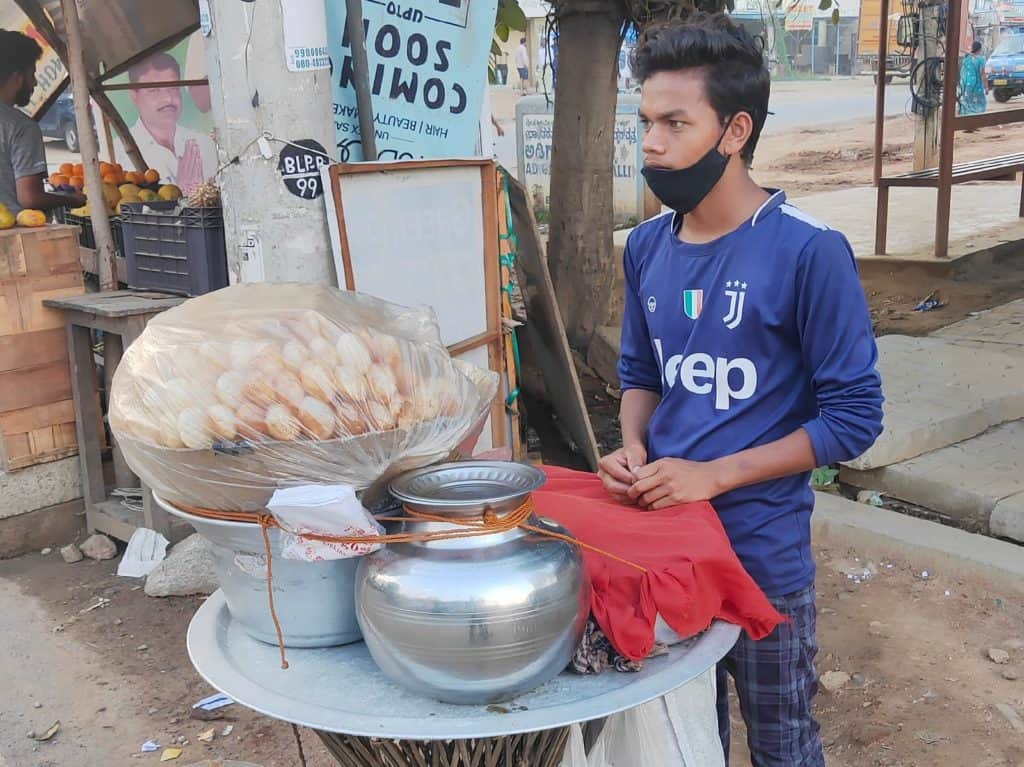Hailing from Naini in Allahabad district, UP, Ajay, 19, runs a roadside gol gappa stall in Sarjapur on the outskirts of Bengaluru. Street vendors are few in this area so the few vendors like Ajay selling street foods like samosas, idlis, vadas, rolls, momos and gol gappas are sought after by students from nearby.
Ajay, who does not face much competition on his street, does brisk business on weekends, especially Sundays, starting at 3 pm and closing shop around 8 pm in the evening. He shares a small home near Billapura with five others, who are also street vendors. A common acquaintance had moved to Bengaluru some years earlier and brought them all to Bengaluru, hiring them to work in his stalls. Ajay and his friends all are paid Rs 9000 a month as salary along with free food and accommodation.
“The daily expenses of running my stall work out to Rs 200-300 while earnings are around Rs 1000-1200,” says Ajay. The earnings from the stall go to the stall owner in return for the monthly salary, part of which Ajay sends home to his family, comprising two elder sisters and ageing parents. The chance to send them money was the main reason for coming to Bengaluru, says Ajay.
Read more: How street vendors survive in “silent” Sadashivanagar
Ajay stopped his studies after passing his 8th standard as he did not have enough resources to continue his education. He adds, “Also lack of guidance has was another reason to drop out from schooling. But I want to pursue my education if the situation turns in my favour”.
The economics of a gol gappa stall
“People prefer restaurants like McDonald’s and Café Coffee Day even though gol gappas are a traditional snack,” rues Ajay, adding however that demand for his gol gappas has been consistant during the six months he has been here. The price rise has meant the price of one plate of gol gappas has almost doubled, from Rs 20 for 10 pieces to Rs 20 for just six pieces at present. Talking to Ajay givs a rough idea of the economics.
| Ingredients | Cost(Rs/kg) | Quantity used (Kg) | Final cost (Rs) |
| Coriander leaves | 80 | 0.25 | 20 |
| Mint leaves | 50 | 0.25 | 13 |
| Potato | 35 | 2 | 70 |
| Black gram | 60 | 0.5 | 30 |
| Onion | 30 | 2 | 60 |
| 203 |
Daily expenses of running a Golgappa stall
| Ingredients | Cost(Rs/kg) | Quantity used(Kg) | Final cost(Rs) |
| Chat Masala | 370 | 0.3 | 111 |
| Tamarind | 200 | 0.5 | 100 |
| Red chilli powder | 1000 | 0.1 | 100 |
| Amchoor powder | 1000 | 0.125 | 50 |
| sooji | 50 | 2 | 100 |
| Maida | 24 | 1 | 24 |
| Baking soda | 50 | 0.25 | 13 |
| 498 |
Other ingredients used on a weekly basis to run gol gappa stall
| Piece per plate | 6 |
| Daily revenue | Rs 900-1100 |
| Daily expenses (approx) | Rs 270 |
| Daily profit (average) | Rs 750 |
| Monthly profit | Rs 22500 |
| Ajay’s salary | Rs 9000 |
Average earnings per month

Post pandemic, Ajay had found it difficult to find a job with a good income back home. So when he was offered this street vending job, he decided to accept. “I would have preferred staying back in my native place even if it meant earning ₹1000 less”, says Ajay. “But the offer of my current employer was hard to reject.”
Read more: “Street vendors are claimants, not intruders”
However not all is smooth sailing in Bengaluru. “Bengaluru is an expensive city and my savings are less than expected,” says Ajay.
A major problem for Ajay is that lack of formal recognition for his stall. Whenever the cops come, he has to vacate the place and run with all the materials. At times, he has had bribe the officers to let him continue vending. “My boss gets very angry when I tell him I had to give money to officers,” says Ajay. He has even threatened to cut the bribe money from Ajay’s salary.
Ajay’s dream is to be able to own his own small stall one day. Till then, Ajay’s only goal is to earn as much as he can, so that he can go back home with some money in his pocket in a couple of years.
Street vending, a popular job
There are 40 to 50 lakh street vendors in India in cities like Delhi, Mumbai, Bengaluru and Ahmedabad who make up 14% of the informal employment sector. The PM SVANidhi scheme was launched in June 2020 by the Ministry of Housing and Urban Affairs with the objective of providing monetary credit for working capital to street vendors who had lost all income due to the lockdown. But those like Ajay who have recently got into the space, and lack formal id cards from the local authorities cannot benefit from the scheme.
Also read: